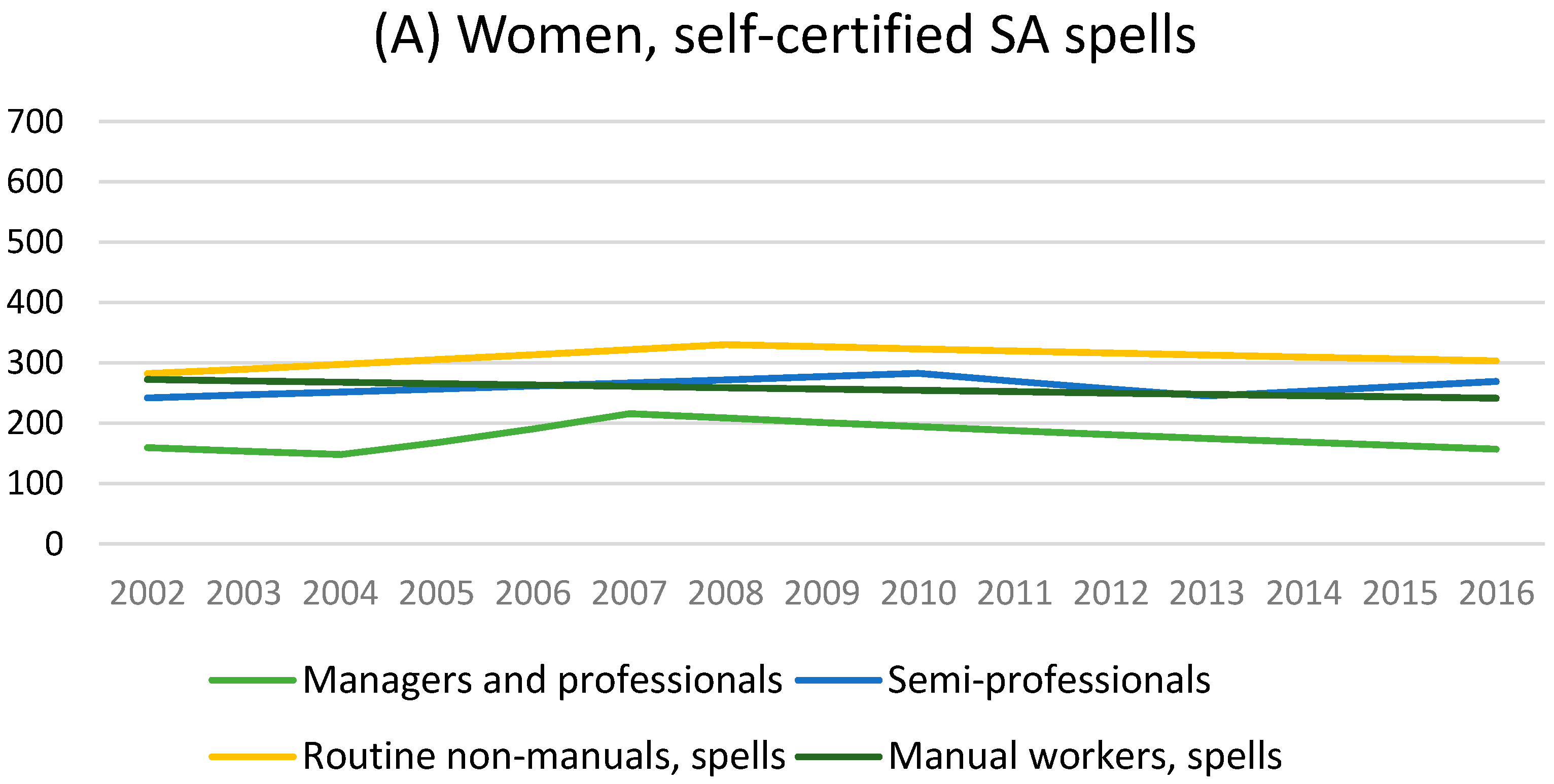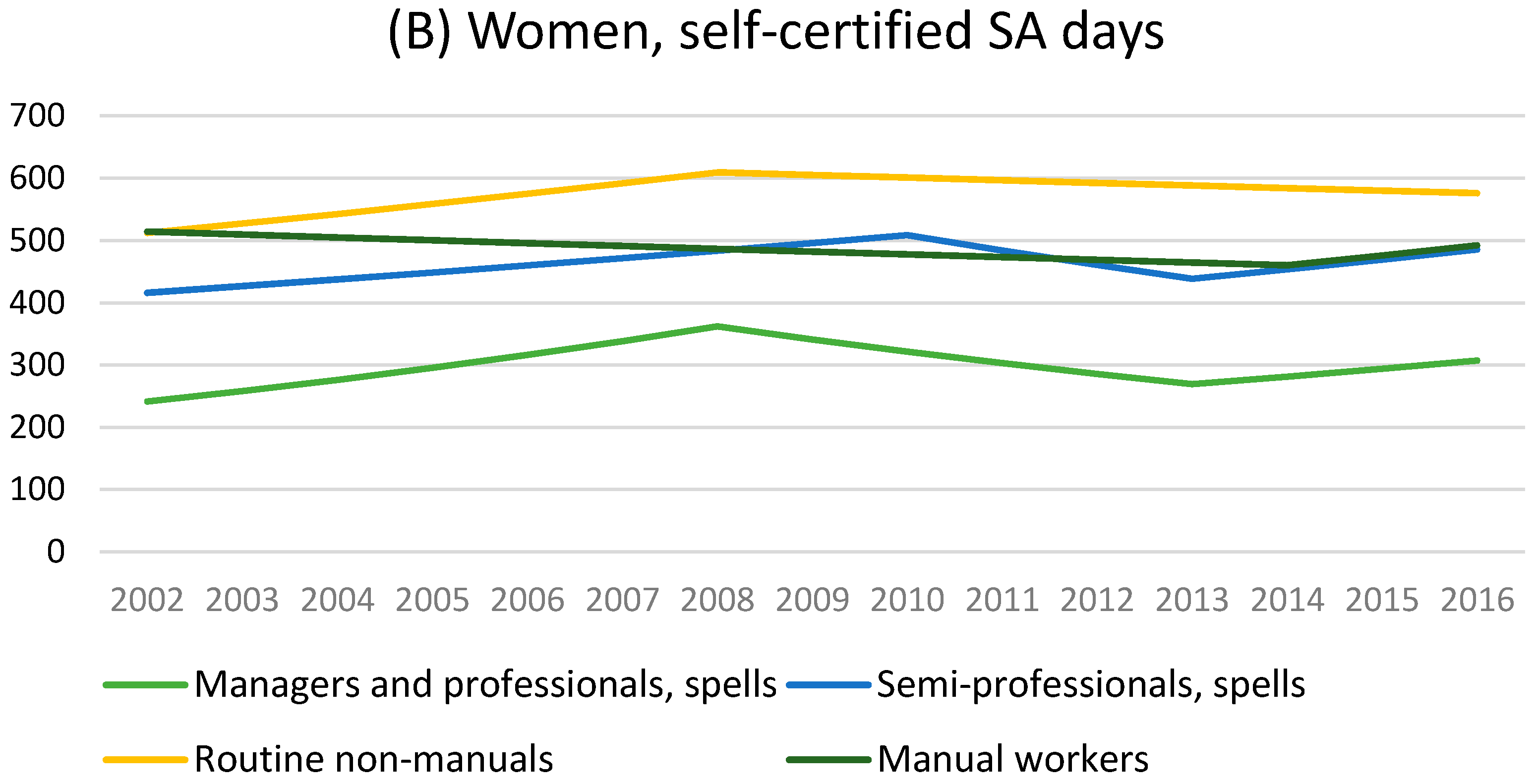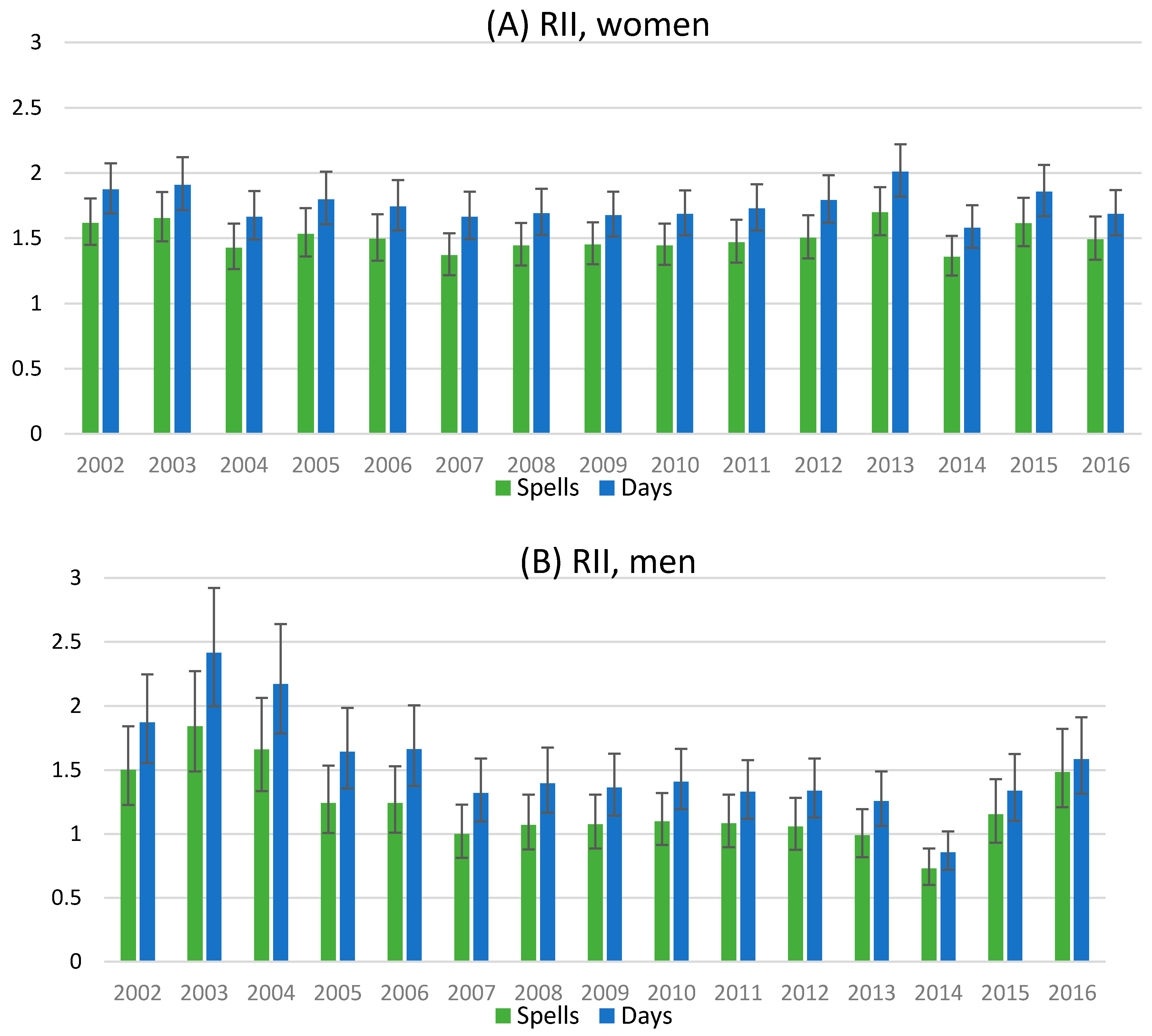Self-Certified Sickness Absence among Young Municipal Employees—Changes from 2002 to 2016 and Occupational Class Differences
Abstract
:1. Introduction
2. Materials and Methods
2.1. Participants
2.2. Sickness Absence
2.3. Occupational Class
2.4. Statistical Methods
3. Results
3.1. Changes in the Sickness Absence Trends
3.2. The Magnitude of Socioeconomic Differences
4. Discussion
Methodological Considerations
5. Conclusions
Acknowledgments
Author Contributions
Conflicts of Interest
References
- Marmot, M.; Feeney, A.; Shipley, M.; North, F.; Syme, S. Sickness absence as a measure of health status and functioning: From the UK Whitehall II study. J. Epidemiol. Community Health 1995, 49, 124–130. [Google Scholar] [CrossRef] [PubMed]
- Vahtera, J.; Virtanen, P.; Kivimäki, M.; Pentti, J. Workplace as an origin of health inequalities. J. Epidemiol. Community Health 1999, 53, 399–407. [Google Scholar] [CrossRef] [PubMed]
- Janssen, N.; Kant, I.; Swaen, G.; Janssen, P.; Schroer, C. Fatigue as a predictor of sickness absence: Results from the Maastricht cohort study on fatigue at work. Occup. Environ. Med. 2003, 60, i71–i76. [Google Scholar] [CrossRef] [PubMed]
- Vahtera, J.; Kivimäki, M.; Pentti, J.; Linna, A.; Virtanen, M.; Virtanen, P.; Ferrie, J.E. Organisational downsizing, sickness absence, and mortality: 10-town prospective cohort study. BMJ 2004, 328, 555. [Google Scholar] [CrossRef] [PubMed]
- Ala-Mursula, L.; Vahtera, J.; Kouvonen, A.; Väänänen, A.; Linna, A.; Pentti, J.; Kivimäki, M. Long hours in paid and domestic work and subsequent sickness absence: Does control over daily working hours matter? Occup. Environ. Med. 2006, 63, 608–616. [Google Scholar] [CrossRef] [PubMed]
- Roelen, C.; Heymans, M.; Twisk, J.; van Rhenen, W.; Pallesen, S.; Bjorvatn, B.; Moen, B.E.; Magerøy, N. Updating and prospective validation of a prognostic model for high sickness absence. Int. Arch. Occup. Environ. Health 2014, 88, 113–122. [Google Scholar] [CrossRef] [PubMed]
- Hultin, H.; Lindholm, C.; Malfert, M.; Möller, J. Short-term sick leave and future risk of sickness absence and unemployment—The impact of health status. BMC Public Health 2012, 12, 861. [Google Scholar] [CrossRef] [PubMed]
- Laaksonen, M.; He, L.; Pitkäniemi, J. The durations of past sickness absences predict future absence episodes. J. Occup. Environ. Med. 2013, 55, 87–92. [Google Scholar] [CrossRef] [PubMed]
- Sumanen, H.; Pietiläinen, O.; Lahti, J.; Lahelma, E.; Rahkonen, O. Sickness absence among young employees: Trends from 2002 to 2013. J. Occup. Health 2015, 57, 474–481. [Google Scholar] [CrossRef] [PubMed]
- Arola, H.; Pitkänen, M.; Nygård, C.H.; Huhtala, H.; Manka, M. The connection between age, job control and sickness absences among Finnish food workers. Occup. Med. 2013, 53, 229–230. [Google Scholar] [CrossRef]
- Barham, C.; Leonard, J. Trends and sources of data on sickness absence. Labour Market Trends 2002, 110, 177–185. [Google Scholar]
- Thorsen, S.; Friborg, C.; Lundström, B.; Kausto, J.; Örnelius, K.; Sundell, T.; Kalsto, Å.M.; Gross, B.-O.; Petersen, H.; Haram, Ö. Sickness Absence in the Nordic Countries; Nordic Social Statistical Committee: Copenhagen, Denmark, 2015. [Google Scholar]
- Donders, N.; Bos, J.; van der Velden, K.; van der Gulden, J. Age differences in the associations between sick leave and aspects of health, psychosocial workload and family life: A cross-sectional study. BMJ Open 2012, 2, e000960. [Google Scholar] [CrossRef] [PubMed]
- Taimela, S.; Läärä, E.; Malmivaara, A.; Tiekso, J.; Sintonen, H.; Justen, S.; Aro, T. Selfreported health problems and sickness absence in different age groups predominantly engaged in physical work. Occup. Environ. Med. 2007, 64, 739–746. [Google Scholar] [CrossRef] [PubMed]
- Thomson, L.; Griffiths, A.; Davison, S. Employee absence, age and tenure: A study of nonlinear effects and trivariate models. Work Stress 2000, 14, 16–34. [Google Scholar] [CrossRef]
- Rhodes, S. Age-related differences in work attitudes and behavior: A review and conceptual analysis. Psychol. Bull. 1983, 93, 328–367. [Google Scholar] [CrossRef]
- Scneider, B. Interactional psychology and organizational behavior. In Research in Organizational Behavior, 5th ed.; Cummingsm, L., Staw, B., Eds.; JAI Press: Greenwitch, CT, USA, 1983; pp. 1–31. [Google Scholar]
- Winding, T.; Labriola, M.; Nohr, E.; Andersen, J. The experience of demanding work environments in younger workers. Occup. Med. 2015, 65, 324–330. [Google Scholar] [CrossRef] [PubMed]
- Sekine, M.; Chandola, T.; Martikainen, P.; Marmot, M.; Kagamimori, S. Socioeconomic inequalities in physical and mental functioning of British, Finnish, and Japanese civil servants: Role of job demand, control, and work hours. Soc. Sci. Med. 2009, 69, 1417–1425. [Google Scholar] [CrossRef] [PubMed]
- Pekkala, J.; Blomgren, J.; Pietiläinen, O.; Lahelma, E.; Rahkonen, O. Occupational class differences in long sickness absence: A register-based study of 2.1 million Finnish women and men in 1996–2013. BMJ Open 2017, 7, e014325. [Google Scholar] [CrossRef] [PubMed]
- Christensen, K.; Labriola, M.; Lund, T.; Kivimäki, M. Explaining the social gradient in long-term sickness absence: A prospective study of Danish employees. J. Epidemiol. Community Health 2008, 62, 181–183. [Google Scholar] [CrossRef] [PubMed]
- Piha, K.; Martikainen, P.; Rahkonen, O.; Roos, E.; Lahelma, E. Trends in socioeconomic differences in sickness absence among Finnish municipal employees 1990–99. Scand. J. Public Health 2007, 35, 348–355. [Google Scholar]
- Feeney, A.; North, F.; Head, J.; Canner, R.; Marmot, M. Socioeconomic and sex differentials in reason for sickness absence from the Whitehall II Study. Occup. Environ. Med. 1998, 55, 91–98. [Google Scholar] [CrossRef] [PubMed]
- Virtanen, M.; Kawachi, I.; Oksanen, T.; Salo, P.; Tuisku, K.; Pulkki-Råback, L.; Pentti, J.; Elovainio, M.; Vahtera, J.; Kivimäki, M. Socio-economic differences in long-term psychiatric work disability: Prospective cohort study of onset, recovery and recurrence. Occup. Environ. Med. 2011, 68, 791–798. [Google Scholar] [CrossRef] [PubMed]
- Morikawa, Y.; Martikainen, P.; Head, J.; Marmot, M.; Ishizaki, M.; Nakagawa, H. A comparison of socio-economic differences in long-term sickness absence in a Japanese cohort and a British cohort of employed men. Eur. J. Public Health 2004, 14, 413–416. [Google Scholar] [CrossRef] [PubMed]
- Hansen, H.; Ingebrigtsen, T. Social class and sickness absence in Norway. Acta Sociol. 2008, 51, 309–327. [Google Scholar] [CrossRef]
- Löve, J.; Hensing, G.; Holmgren, K.; Toren, K. Explaining the social gradient in sickness absence: A study of a general working population in Sweden. BMC Public Health 2013, 13, 545. [Google Scholar] [CrossRef] [PubMed]
- Sumanen, H.; Lahti, J.; Lahelma, E.; Pietiläinen, O.; Rahkonen, O. 12-year trends in occupational class differences in short sickness absence among young women. Scand. J. Public Health 2015, 43, 441–444. [Google Scholar]
- Kristensen, T.; Jensen, S.; Kreiner, S.; Mikkelsen, S. Socioeconomic status and duration and pattern of sickness absence. A 1-year follow-up study of 2331 hospital employees. BMC Public Health 2010, 10, 643. [Google Scholar] [CrossRef] [PubMed]
- Finnish Advisory Board on Research Integrity. Ethical Review. Available online: http://www.tenk.fi/en/ethical-review-human-sciences/ethical-review (accessed on 26 August 2017).
- Lahelma, E.; Aittomäki, A.; Laaksonen, M.; Lallukka, T.; Martikainen, P.; Piha, K.; Rahkonen, O.; Saastamoinen, P. Cohort profile: The Helsinki Health Study. Int. J. Epidemiol. 2013, 42, 722–730. [Google Scholar] [CrossRef] [PubMed]
- Kim, H.J.; Fay, M.P.; Feuer, E.J.; Midthune, D.N. Permutation tests for joinpoint regression with applications to cancer rates. Stat. Med. 2000, 19, 335–351. [Google Scholar] [CrossRef]
- National Cancer Institute. Joinpoint Regression Program; National Cancer Institute: Bethesda, MD, USA, 2014.
- Moreno-Betancur, M.; Latouche, A.; Menvielle, G.; Kunst, A.E.; Rey, G. Relative index of inequality and slope index of inequality: A structured regression framework for estimation. Epidemiology 2015, 26, 518–527. [Google Scholar] [CrossRef] [PubMed]
- Pichler, S. Sickness absence, moral hazard, and the business cycle. Health Econ. 2015, 24, 692–710. [Google Scholar] [CrossRef] [PubMed]
- Statistics Finland. Consumer Confidence Continued as Strong in August. Available online: http://www.stat.fi/til/kbar/2017/08/kbar_2017_08_2017-08-28_tie_001_en.html (accessed on 15 September 2017).
- Laaksonen, M.; Piha, K.; Rahkonen, O.; Martikainen, P.; Lahelma, E. Explaining occupational class differences in sickness absence: Results from middle-aged municipal employees. J. Epidemiol. Community Health 2010, 64, 802–807. [Google Scholar] [CrossRef] [PubMed]
- Borg, K.; Hensing, G.; Alexanderson, K. Prediction of future low levels of sickness absence among young persons sick listed with back, neck, or shoulder diagnoses. Work 2004, 23, 159–167. [Google Scholar] [PubMed]
- Melchior, M.; Krieger, N.; Kawachi, I.; Berkman, L.F.; Niedhammer, I.; Goldberg, M. Work factors and occupational class disparities in sickness absence: Findings from the GAZEL cohort study. Am. J. Public Health 2005, 95, 1206–1212. [Google Scholar] [CrossRef] [PubMed]
- Sumanen, H.; Lahelma, E.; Pietiläinen, O.; Rahkonen, O. The magnitude of occupational class differences in sickness absence: 15-year trends among young and middle-aged municipal employees. Int. J. Environ. Res. Public Health 2017, 14, 625. [Google Scholar] [CrossRef] [PubMed]
- Sumanen, H.; Lahelma, E.; Lahti, J.; Pietiläinen, O.; Rahkonen, O. Educational differences in sickness absence trends among young employees from 2002 to 2013 in Helsinki, Finland. BMJ Open 2016, 6, e008550. [Google Scholar] [CrossRef] [PubMed]
- Huijts, T.; Eikemo, T.; Skalicka, V. Income-related health inequalities in the Nordic countries: Examining the role of education, occupational class, and age. Soc. Sci. Med. 2010, 71, 1964–1972. [Google Scholar] [CrossRef] [PubMed]
- Tolonen, A.; Rahkonen, O.; Lahti, J. Leisure-time physical activity and direct cost of short-term sickness absence among Finnish municipal employees. Arch. Environ. Occup. Health 2017, 72, 93–98. [Google Scholar] [CrossRef] [PubMed]
- Verhaeghe, R.; Mak, R.; van Maele, G.; Kornitzer, M.; de Backer, G. Job stress among middle-aged health care workers and its relation to sickness absence. Stress Health 2003, 19, 265–274. [Google Scholar] [CrossRef]
- Moncada, S.; Navarro, A.; Cortes, I.; Molinero, E.; Artazcoz, L. Sickness leave, administrative category and gender: Results from the “Casa Gran” project. Scand. J. Public Health 2002, 30, 26–33. [Google Scholar]




| Year | ||||
|---|---|---|---|---|
| 2002 | 2009 | 2016 | ||
| Women, n | All | 8789 | 9225 | 8926 |
| Managers and professionals, % | 12.1 | 12.7 | 11.5 | |
| Semi-professionals, % | 23.7 | 23.0 | 30.2 | |
| Routine non-manuals, % | 51.0 | 52.3 | 48.9 | |
| Manual workers, % | 13.1 | 12.1 | 9.4 | |
| Women, SA * spells | Managers and professionals | 146 | 187 | 175 |
| (/100 person-years) | Semi-professionals | 230 | 249 | 253 |
| Routine non-manuals | 278 | 319 | 307 | |
| Manual workers | 275 | 270 | 258 | |
| Women, SA * days | Managers and professionals | 237 | 313 | 295 |
| (/100 person-years) | Semi-professionals | 401 | 450 | 455 |
| Routine non-manuals | 507 | 591 | 578 | |
| Manual workers | 518 | 523 | 490 | |
| Men, n | All | 2742 | 3065 | 2743 |
| Managers and professionals, % | 13.9 | 13.6 | 14.9 | |
| Semi-professionals, % | 13.5 | 12.7 | 17.8 | |
| Routine non-manuals, % | 31.4 | 32.0 | 36.2 | |
| Manual workers, % | 41.3 | 41.7 | 31.2 | |
| Men, SA * spells | Managers and professionals | 97 | 120 | 124 |
| (/100 person-years) | Semi-professionals | 176 | 191 | 203 |
| Routine non-manuals | 236 | 283 | 281 | |
| Manual workers | 198 | 191 | 218 | |
| Men, SA * days | Managers and professionals | 160 | 209 | 223 |
| (/100 person-years) | Semi-professionals | 304 | 355 | 369 |
| Routine non-manuals | 427 | 526 | 531 | |
| Manual workers | 389 | 405 | 419 | |
| Women | Men | |||
|---|---|---|---|---|
| Identified Periods (Turning Points) | Annual % Change (95% CI) | Identified Periods (Turning Points) | Annual % Change (95% CI) | |
| Self-certified sickness absence spells | ||||
| Managers and professionals | 2002–2004 2004–2007 2007–2016 | −3.7 (−26.3, 25.9) 13.4 (−11.0, 44.6) −3.5 (−5.7, −1.2) | 2002–2016 | 2.7 (0.0, 5.4) |
| Semi-professionals | 2002–2010 2010–2013 2013–2016 | 2.0 (0.4, 3.5) −4.6 (−15.4, 7.5) 3.2 (−2.9, 9.6) | 2002–2007 2007–2016 | 6.5 (−4.2, 18.5) −1.4 (−5.1, 2.6) |
| Routine non-manuals | 2002–2008 2008–2016 | 2.7 (0.9, 4.5) −1.1 (−2.1, 0.0) | 2002–2004 2004–2009 2009–2014 2014–2016 | −2.0 (−6.2, 2.4) 5.0 (3.6, 6.4) −2.3 (−3.4, −1.2) 4.1 (0.5, 7.9) |
| Manual workers | 2002–2016 | −0.9 (−1.7, 0.0) | 2002–2014 2014–2016 | −1.7 (−2.7, −0.8) 10.0 (−10.0, 34.5) |
| Self-certified sickness absence days | ||||
| Managers and professionals | 2002–2008 2008–2013 2013–2016 | 7.0 (0.3, 14.2) −5.7 (−15.0, 4.6) 4.5 (−14.7, 28.0) | 2002–2016 | 3.5 (1.0, 6.2) |
| Semi-professionals | 2002–2010 2010–2013 2013–2016 | 2.5 (1.2, 3.9) −4.8 (−13.9, 5.2) 3.5 (−1.7, 8.8) | 2002–2007 2007–2016 | 8.8 (−2.5, 21.3) −1.2 (−4.9, 2.8) |
| Routine non-manuals | 2002–2008 2008–2016 | 2.9 (1,2, 4,7) −0.7 (−1,7, 0,3) | 2002–2010 2010–2014 2014–2016 | 3.7 (2.0, 5.4) −2.8 (−8.8, 3.6) 4.8 (−7.6, 18.9) |
| Manual workers | 2002–2014 2014–2016 | −0.9 (−2.0, 0.1) 3.4 (−16.4, 28.0) | 2002–2011 2011–2014 2014–2016 | 0.6 (−0.5, 1.7) −10.3 (−20.1, 0.7) 17.1 (0.6, 36.3) |
© 2017 by the authors. Licensee MDPI, Basel, Switzerland. This article is an open access article distributed under the terms and conditions of the Creative Commons Attribution (CC BY) license (http://creativecommons.org/licenses/by/4.0/).
Share and Cite
Sumanen, H.; Pietiläinen, O.; Mänty, M. Self-Certified Sickness Absence among Young Municipal Employees—Changes from 2002 to 2016 and Occupational Class Differences. Int. J. Environ. Res. Public Health 2017, 14, 1131. https://doi.org/10.3390/ijerph14101131
Sumanen H, Pietiläinen O, Mänty M. Self-Certified Sickness Absence among Young Municipal Employees—Changes from 2002 to 2016 and Occupational Class Differences. International Journal of Environmental Research and Public Health. 2017; 14(10):1131. https://doi.org/10.3390/ijerph14101131
Chicago/Turabian StyleSumanen, Hilla, Olli Pietiläinen, and Minna Mänty. 2017. "Self-Certified Sickness Absence among Young Municipal Employees—Changes from 2002 to 2016 and Occupational Class Differences" International Journal of Environmental Research and Public Health 14, no. 10: 1131. https://doi.org/10.3390/ijerph14101131





